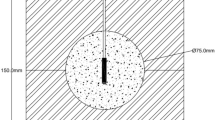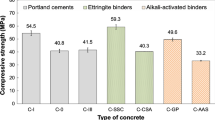Abstract
The formulation of ultra-high-performance concrete necessitates the use of a high cement content. The alkaline nature of cement makes it susceptible to acid attacks. In addition, its high C3A content causes its vulnerability to sulfate attack under the development of expansive ettringite, where porosity plays an important role. The main objective of this study was to figure out how mass loss and dimensional instability affected the rate of reaction and its relationship to acid concentration. It is noted that in contrast to sulfuric acid attack, sulfate attack on ultra-high-performance concrete (UHPC) is characterized by the accumulation of sulfate ions near the surface until reaching a critical concentration known as the threshold value. However, the reaction effect was not remarkable, as attributed to the extremely low porosity. The effect of curing was found to have a minimal influence on acid resistivity because it is a kind of spontaneous acid-base reaction that cannot be alleviated. In this research work, the UHPC’s service life can be predicted when exposed to different concentrations of sulfuric acid. When comparing acid and sulfate attacks, the latter becomes negligible. Despite the use of silica fume and fly ash, the reactivity with sulfuric acid was found to occur spontaneously and rely on cement content and acid concentration. A concentration of 2.5% sulfuric acid is the threshold concentration after which a substantial change in the development of strength takes place. Both reactions were monitored on different types of samples over time using several techniques, such as XRD, TGA, and DSC and optical microscopy.
























Similar content being viewed by others
References
Aïtcin, P.-C.: High performance concrete. CRC Press, Florida (2011)
Almusallam, A.A.; Khan, F.M.; Dulaijan, S.U.; Al-Amoudi, O.S.B.: Effectiveness of surface coatings in improving concrete durability. Cem. Concr. Compos. 25, 473–481 (2003). https://doi.org/10.1016/S0958-9465(02)00087-2
Pfeifer DW, Scali MJ: Concrete sealers for protection of bridge structures (NCHRP report). (1981)
Aguiar, J.B.; Camões, A.; Moreira, P.M.: Coatings for concrete protection against aggressive environments. J. Adv. Concr. Technol. 6, 243–250 (2008). https://doi.org/10.3151/jact.6.243
Tahri, W.; Abdollahnejad, Z.; Mendes, J.; Pacheco-Torgal, F.; de Aguiar, J.B.: Cost efficiency and resistance to chemical attack of a fly ash geopolymeric mortar versus epoxy resin and acrylic paint coatings. Eur. J. Environ. Civ. Eng. 21, 555–571 (2017). https://doi.org/10.1080/19648189.2015.1134674
Rahmani, H.; Ramazanianpour, A.A.: Effect of binary cement replacement materials on sulfuric acid resistance of dense concretes. Mag. Concr. Res. 60, 145–155 (2008). https://doi.org/10.1680/macr.2008.60.2.145
Hewayde, E.; Nehdi, M.; Allouche, E.; Nakhla, G.: Effect of mixture design parameters and wetting-drying cycles on resistance of concrete to sulfuric acid attack. J. Mater. Civ. Eng. 19, 155–163 (2007). https://doi.org/10.1061/(ASCE)0899-1561(2007)19:2(155)
Koenig, A., Dehn, F.: Acid resistance of ultra high-performance concrete (UHPC). In: Nanotechnology in construction. pp. 317–323. Springer International Publishing, Cham (2015)
Madraszewski, S.; Sielaff, A.M.; Stephan, D.: Acid attack on concrete—damage zones of concrete and kinetics of damage in a simulating laboratory test method for wastewater systems. Constr. Build. Mater. 366, 130121 (2023). https://doi.org/10.1016/j.conbuildmat.2022.130121
Alexander, M.G.; Fourie, C.: Performance of sewer pipe concrete mixtures with portland and calcium aluminate cements subject to mineral and biogenic acid attack. Mater. Struct. 44, 313–330 (2011). https://doi.org/10.1617/s11527-010-9629-1
Senhadji, Y.; Escadeillas, G.; Mouli, M.; Khelafi, H.: Benosman: Influence of natural pozzolan, silica fume and limestone fine on strength, acid resistance and microstructure of mortar. Powder Technol. 254, 314–323 (2014). https://doi.org/10.1016/j.powtec.2014.01.046
He, K.; Yang, H.; Lu, Z.; Jia, F.; Wang, E.; Dong, Q.: Effect of matrix modification on durability of cementitious composites in an acid rain environment. J. Wuhan Univ. Technol.-Mater Sci. Ed. 29, 498–503 (2014). https://doi.org/10.1007/s11595-014-0947-y
Lavigne, M.P.; Bertron, A.; Botanch, C.; Auer, L.; Hernandez-Raquet, G.; Cockx, A.; Foussard, J.-N.; Escadeillas, G.; Paul, E.: Innovative approach to simulating the biodeterioration of industrial cementitious products in sewer environment. Part II: Validation on CAC and BFSC linings. Cem. Concr. Res. 79, 409–418 (2016). https://doi.org/10.1016/j.cemconres.2015.10.002
De Belie, N.; Monteny, J.; Beeldens, A.; Vincke, E.; Van Gemert, D.; Verstraete, W.: Experimental research and prediction of the effect of chemical and biogenic sulfuric acid on different types of commercially produced concrete sewer pipes. Cem. Concr. Res. 34, 2223–2236 (2004). https://doi.org/10.1016/j.cemconres.2004.02.015
Huber, B.; Hilbig, H.; Mago, M.M.; Drewes, J.E.; Müller, E.: Comparative analysis of biogenic and chemical sulfuric acid attack on hardened cement paste using laser ablation-ICP-MS. Cem. Concr. Res. 87, 14–21 (2016). https://doi.org/10.1016/j.cemconres.2016.05.003
Skalny J.; Brown P.: Sulfate attack on concrete. (2002)
Shannag, M.J.; Shaia, H.A.: Sulfate resistance of high-performance concrete. Cem. Concr. Compos. 25, 363–369 (2003). https://doi.org/10.1016/S0958-9465(02)00049-5
Tamimi, A.K.: High-performance concrete mix for an optimum protection in acidic conditions. Mater. Struct. 30, 188–191 (1997). https://doi.org/10.1007/BF02486392
Sulfate Resistance of Concrete Containing Mineral Admixtures. ACI Mater J. 97, (2000). https://doi.org/10.14359/9286
American Society for Testing and Materials (ASTM): Standard Specification for Portland Cement (ASTM C150–09). , West Conshohocken, PA, USA (2009)
American Society for Testing and Materials (ASTM): Standard Test Method for Density, Relative Density (Specific Gravity), and Absorption of Fine Aggregate (-ASTM C128–01). , West Conshohocken, PA, USA (2017)
Khan, M.I.; Fares, G.; Abbas, Y.M.: Cost-performance balance and new image analysis technique for ultra-high performance hybrid nano-based fiber-reinforced concrete. Constr. Build. Mater. 315, 125753 (2022). https://doi.org/10.1016/j.conbuildmat.2021.125753
Khan, M.I.; Fares, G.; Abbas, Y.M.: Behavior of non-shear-strengthened UHPC beams under flexural loading: influence of reinforcement depth. Appl. Sci. 11, 11168 (2021). https://doi.org/10.3390/app112311168
Irico, S.; De Meyst, L.; Qvaeschning, D.; Alonso, M.C.; Villar, K.; De Belie, N.: Severe sulfuric acid attack on self-compacting concrete with granulometrically optimized blast-furnace slag-comparison of different test methods. Materials 13, 1431 (2020). https://doi.org/10.3390/ma13061431
Shariati, M.; Kamyab, H.; Habibi, M.; Ahmadi, S.; Naghipour, M.; Gor**ezhad, F.; Mohammadirad, S.; Aminian, A.: Sulfuric acid resistance of concrete containing coal waste as a partial substitute for fine and coarse aggregates. Fuel 348, 128311 (2023). https://doi.org/10.1016/j.fuel.2023.128311
American Society for Testing and Materials (ASTM): Standard Test Method for Length Change of Hydraulic-Cement Mortars Exposed to a Sulfate Solution (ASTM 1012). , Conshohocken, PA, USA (2013)
Vande Voort, T.L.; Suleiman, M.T.; Sritharan, S.: Design and performance verification of UHPC piles for deep foundations. Iowa, USA (2008)
Jiang, X.; Mu, S.; Guo, Z.; Liu, G.: Effect of temperature on the physical salt attack of cement mortars under repeated partial immersion in sodium sulfate solution. Materials 15, 6234 (2022). https://doi.org/10.3390/ma15186234
Jiang, X.; Mu, S.; Yang, Z.; Tang, J.; Li, T.: Effect of temperature on durability of cement-based material to physical sulfate attack. Constr. Build. Mater. 266, 120936 (2021). https://doi.org/10.1016/j.conbuildmat.2020.120936
Alyami, M.H.; Alrashidi, R.S.; Mosavi, H.; Almarshoud, M.A.; Riding, K.A.: Potential accelerated test methods for physical sulfate attack on concrete. Constr. Build. Mater. 229, 116920 (2019). https://doi.org/10.1016/j.conbuildmat.2019.116920
ACI Committee 201 (ACI 201.2R-01): Guide to Durable Concrete. , MI, USA. (2008)
Bassuoni, M.T.; Nehdi, M.L.: Resistance of self-consolidating concrete to sulfuric acid attack with consecutive pH reduction. Cem. Concr. Res. 37, 1070–1084 (2007). https://doi.org/10.1016/j.cemconres.2007.04.014
Gutberlet, T.; Hilbig, H.; Beddoe, R.E.: Acid attack on hydrated cement—effect of mineral acids on the degradation process. Cem. Concr. Res. 74, 35–43 (2015). https://doi.org/10.1016/j.cemconres.2015.03.011
Kumar, R.; Verma, M.; Dev, N.; Lamba, N.: Influence of chloride and sulfate solution on the long-term durability of modified rubberized concrete. J. Appl. Polym. Sci. (2022). https://doi.org/10.1002/app.52880
Acknowledgements
The authors extend their appreciation to Researcher Supporting Project number (RSPD2024R692), King Saud University, Riyadh, Kingdom of Saudi Arabia.
Author information
Authors and Affiliations
Corresponding author
Rights and permissions
Springer Nature or its licensor (e.g. a society or other partner) holds exclusive rights to this article under a publishing agreement with the author(s) or other rightsholder(s); author self-archiving of the accepted manuscript version of this article is solely governed by the terms of such publishing agreement and applicable law.
About this article
Cite this article
Fares, G., Abbas, Y.M. & Khan, M.I. Deterioration Mechanisms of Ultra-High-Performance Concrete Under Various Sulfuric Acid and Sulfate Attack Conditions. Arab J Sci Eng (2024). https://doi.org/10.1007/s13369-024-09139-7
Received:
Accepted:
Published:
DOI: https://doi.org/10.1007/s13369-024-09139-7




